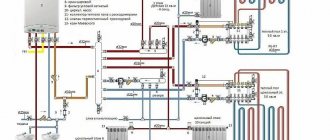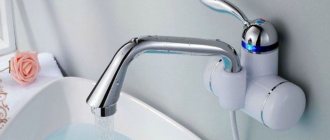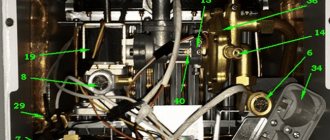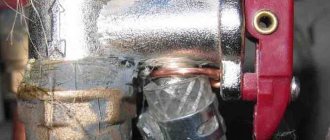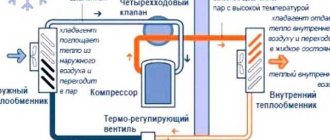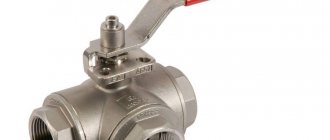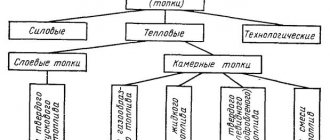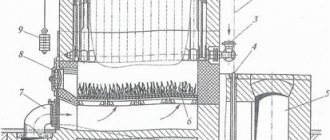Types of storage water heaters
At the moment, there are several types of units for autonomous hot water supply. They are all created with one goal, but achieve it in different ways, that is, using different energy carriers. The homeowner has the opportunity to choose the one that best suits him in all respects.
So, the following types of heating boilers are offered on the modern market:
- electric storage heaters;
- indirect heating boilers;
- gas boilers;
- flow heaters.
Note. Directly translated from English, the word “boiler” means “boiler”. This means that they include not only storage, but also all kinds of instantaneous water heaters. Not taking them into account would be unfair to users.
Operating principle of the boiler
An electric boiler consists of the following parts: heater body, thermal insulation layer, storage tank, heating element, magnesium anode, temperature sensor.
The storage tank is made of stainless steel and coated with special enamel or titanium. Heat-insulating materials are used on the outside of the tank. This can be polyurethane foam or foam rubber. To prevent the internal coating of the tank from corroding, a magnesium anode is used. The capacity of the water storage tank can vary from 10 to 200 liters.
The boiler works according to the following principle - a heating element, which is placed in a storage tank, heats cold water coming from below. Hot water is discharged from the top of the boiler. It turns out that the heated water is gradually pushed out of the water supply system by pressure as it is used.
If the water has heated to the desired temperature, the heater, thanks to the thermostat, turns off. When the water temperature drops by a few degrees, the thermostat turns the heater back on. The desired temperature is set using the adjustable rotary knob. Thermostats or temperature sensors are bimetallic plates that open an electrical circuit when heated to a given temperature. Can be mechanical or electronic.
The time for heating water in the boiler depends on the capacity of the heating tank, the power of the heating element and their number, since some models may have several heaters.
Heating of the heating element is possible in two ways:
- dry, when the heating element is not in contact with water, but is placed in a glass or ceramic tube that performs a protective function. Boilers with dry heating elements are more durable, as they are resistant to scale, and are also distinguished by their high price;
- wet, when the heating elements, which look very similar to a boiler, are lowered directly into the water. Boilers with such a heater are susceptible to corrosion and scale, but have an optimal cost.
Depending on the mounting method, boilers can be suspended, which are installed horizontally or vertically, depending on the location of the tank, or floor-mounted.
For a family of three, based on the hot water needs for washing, washing dishes, showers and baths, a boiler with an average capacity of 100 liters is required.
Thus, the boiler is indispensable in urban and rural living conditions and provides timely and rapid heating of water. Their popularity has increased, as many models of water heaters have optimal prices, good quality and ease of operation.
Category: Water heating
Electric boilers
This is the most common type of hot water supply, most often used in apartments and small private houses. The reason for this popularity is the relatively low cost and ease of installation, which does not require any permits. The devices are quite reliable in operation and satisfy most user requirements. To understand the principle of operation of a water heater, consider its structure shown in the figure:
The unit is a tank, usually round or oval, enclosed in a layer of heat-insulating material (usually polyurethane foam), covered with a decorative casing. The container itself can be made of the following materials:
- steel with enamel coating;
- stainless steel;
- plastic.
An electric heating element located at the bottom of the tank heats the water to a temperature limited by a thermostat. Its maximum value, accepted in all electric boilers, is 75 ºС. While there is no water supply, the design of the electric boiler provides for maintaining the set temperature in the mode of automatically turning the heating element on and off. The latter has additional protection against overheating and in an emergency situation will automatically turn off when the water temperature reaches 85 ºС.
Note : The optimal operating mode for the boiler is heating to 55 ºС. In this mode, the device provides the required amount of water for domestic hot water and at the same time saves energy. Unfortunately, the storage water heater often operates at maximum power due to the fact that in winter the water supplied from the water supply is too cold and the heating element in economical mode does not have time to warm it up.
Water is drawn through a tube leading to the upper zone of the tank, where the water is hottest. At the same time, cold water is supplied to the lower part of the boiler, where the heating element is installed. To protect steel tanks from electrochemical corrosion, the water heater device includes a magnesium anode. Over time, it deteriorates and therefore requires replacement approximately once every 2-3 years.
Types of Electric Water Heaters
The most economical way to heat cold water is to use a gas water heater, but in most cases this heating device is simply impossible to install. Multi-storey buildings most often do not have special systems for removing natural gas combustion waste, and many private houses and summer cottages are not gasified. Therefore, in this case, the installation of electrical appliances to produce hot water has no alternative. All electric water heaters are divided into only two types: storage (boilers) and instantaneous. Below we will briefly look at the operating principle of each type separately.
- Electric storage water heater (boiler). This device is most often called a boiler. The device is a simple water tank with installed heating elements (heating elements) and electronic or mechanical control systems. The container itself is thermally insulated from the external environment, which allows significant energy savings. The operating principle of a storage water heater is static. The tank is filled with cold water and it is heated using heating elements. The entire process of heating and maintaining the required temperature occurs under the control of an automation unit.
- Flow-through electric water heating device. The operating principle of an instantaneous water heater is dynamic. This device does not have a cold water storage tank. The process of heating water with heating elements occurs in special pipes and coils with a constant flow of aqueous medium through these elements. As in storage systems, instantaneous water heaters implement the principle of mechanical or automatic control using an electronic unit. To quickly heat a strong flow of water to the required temperature, the flow-through electric heater must have sufficient power, which is a certain disadvantage.
These two types of electric water heaters may have different designs. There are devices with indirect heating, where thermal energy is transferred to water through an additional coolant in a heat exchange module. In this case, the heating elements heat up a special liquid, which, in turn, transfers heat to the cold water in the heat exchanger. In addition, not only heating elements, but also other devices, for example, infrared sources, can be used as heating elements.
But all these devices are much more expensive, so instantaneous and storage water heaters with direct heating of water by resistance heating elements, that is, heating elements, are mainly used. Below we will take a closer look at the device, operating principle, advantages and disadvantages of both types of electric water heating equipment. This will allow you to make the right choice of device for uninterrupted supply of hot water to your home, office or utility room.
Indirect heating boilers
These devices do not produce thermal energy on their own, although some models have a built-in heating element to maintain the water temperature in different situations. In normal mode, the boiler prepares water for hot water supply, heating it with a coil with coolant flowing through it. The diagram below shows the design of an indirect heating boiler:
A large-capacity insulated tank (sometimes up to 1000 l) has a built-in coil with coolant supplied to it from the boiler. As in an electric boiler, cold water is supplied to the lower part of the tank, and hot water is taken from the upper part. The unit is capable of providing a significant flow of hot water, and therefore is used in private homes with a large number of consumers.
The usual exchange of heat between environments with different temperatures is the operating principle of an indirect heating boiler. But in order to get water from the tap with a temperature of 55 ºС, the boiler must heat the coolant to at least 80 ºС, this is one of the disadvantages of this water heater. The second drawback is the long time it takes to load a large-capacity tank, so in the case of intensive water withdrawal, people living in the house need to adapt to using hot water according to a certain schedule.
Like electric boilers, indirect water heaters are equipped with a magnesium anode to protect the steel tank from corrosion. More complex and expensive models are equipped with two coils; coolant from the boiler flows through one, and the second can be connected to an alternative source of thermal energy. They can be another boiler or a solar collector. To maintain the temperature in different situations, a heating element with a thermostat is built into the upper zone of the container.
Indirect heating units are produced in wall-mounted and floor-mounted versions and can work with any source of thermal energy. Manufacturers of boiler equipment often offer them in conjunction with double-circuit boilers. In this case, the heat generator maintains the heating temperature and loads the boiler, alternately switching between these two systems.
Solar heating boilers
Water solar collectors are not the same as solar panels. Their design is a system of thin tubes through which liquid circulates. Consider two main device options:
- The heated coolant rises up and enters a separate tank where cold water from the water supply is located. Passing through the heat exchanger, the hot coolant heats this water and returns to the solar water heater. The result is a system very similar to an indirect heating boiler, only instead of a furnace or boiler it uses solar energy.
- In another, simpler scheme, a tank is installed at the top of the collector. Heated liquid is collected in it and, displaced by the colder water supply from below, flows through pipes to people.
Collectors are most often placed on the roof or attached to a vertical wall, but so that the maximum amount of sunlight falls on the surface.
A solar collector of a more complex design will be able to heat water not only on hot summer days, but all year round!
So, if efficiency is considered the main selection criterion, the top 3 will look like this:
- Indirect heating boiler (minus - it takes up a lot of space, more suitable for private homes).
- Gas boiler (for apartment residents the most realistic and budget option; there are heating costs, but they are small).
- Solar collector (with considerable initial expenses, subsequently - free heating).
The water heater can be installed either independently or by calling specialists. Installing a water heater yourself requires certain knowledge. Read about the installation requirements for the device. You will find connection diagrams to the electrical network and to the water supply in the article.
Read about choosing an electric storage water heater in this section. Characteristics to consider.
Gas storage water heaters
These devices are structurally and externally reminiscent of electric boilers. The same tank hung on the wall, covered with a layer of insulation, only a gas burner is installed at the bottom, and at the top there is a chimney pipe. A gas boiler works on the same principle, only the heat source is a burner that heats a container of water. The water heater structure is shown in the diagram:
As can be seen in the figure, heating is carried out not only from the burner, but also by removing heat from combustion products. This is achieved through a steel flue with dividers, passing vertically through the container and exchanging heat with the water. The operation of the burner is controlled by an electronic unit, whose task is to extinguish or ignite it when the set temperature is reached or decreased. As usual, to protect the body, the boiler design includes a magnesium anode.
This type of water heater is not very popular due to the difficulties in designing and connecting gas-using installations. In addition, to operate a gas boiler you will need a full-fledged chimney; fulfilling this requirement is not always possible or too expensive.
The advantage of storage water heaters is that they can immediately produce a large flow of water for domestic hot water, but for a limited period of time. After this, they need a break to prepare the next portion of water.
Design Features
To understand what type of heaters you should choose for your home, you should better become familiar with the operating principle and design of an electric storage water heater.
Such a heater consists of the following structural elements :
- Boiler body. Usually made of plastic or stainless steel. Can be made in horizontal or vertical version. The inside has a thick layer of heat insulation.
- Internal water heater tank. This is where the water is stored. The main requirements for it are resistance to corrosion and temperature changes.
- Tube for supplying hot water. Since warm layers of liquid are always located at the top, accordingly, the tube is attached to the top of the boiler.
- Cold water supply pipe. Located at the bottom of the water heater.
- A heating element. Consists of a thermostat and a thermal electric heater. The latter heats the water, and the thermostat controls its temperature and turns off the power supply if the upper limit is exceeded.
- Anode for collecting scale. From the name it is clear what it is intended for. Consists of an alloy with a high magnesium content.
- Water temperature indicator. Can be digital or pointer.
- Protective cover.
This is what a standard storage water heater looks like. Of course, depending on the model and manufacturer, some individual elements may differ, but the general principle is the same for all modifications.
About instantaneous water heaters
Unlike storage boilers, the principle of operation of a flow-through water heater is to quickly heat running water as needed, rather than in advance.
The heat sources are the same electric heating elements and gas burners, only they turn on after the hot water tap in the house opens. Such heaters include:
- geysers;
- flow electric heaters.
Note. Sometimes, to provide hot water supply to a private home, a plate boiler is used, which is a water-to-water heat exchanger. Like an indirect heating boiler, it transfers the energy of the coolant to water, only it does this in flow mode.
The design of the geyser is quite complex, and therefore deserves a separate topic. An electric water heater is simple: a powerful heating element heats running water in it. Having such an advantage as its small size, the device has too high power consumption and therefore its scope of application is limited. The design of a flow-through electric boiler is shown in the figure:
The advantage of instantaneous water heating devices is that they can supply heated water without preparation and for an unlimited time. But its consumption has limits, which is important when there are a large number of consumers.
What is the design of a water heater
So, as we have established, the principle of operation of a storage water heater is that thermal energy is first transferred to the water, which leads to its heating, and then the heat flow decreases and remains at a level sufficient to maintain the required temperature. In a flow-through device, water is heated as it passes through heating elements. Therefore, at the outlet it has a significantly lower temperature than the storage one, although heating to it occurs very quickly.
Storage water heaters have the following device:
- A container that is filled with water from a water supply system under pressure. Its size varies from 10 to 100 liters.
- The outer casing, under which there is a thick layer of thermal insulation.
- Electric heating element (TEH) or magnesium anode. In the case of the gas option - chimney pipes and a gas burner. This is the “heart” of the device, which actually heats the water in the tank.
- A pipe for supplying cold water from the system and a pipe for exiting hot water from the device. It is often equipped with a safety valve that opens when the pressure in the water heater exceeds.
- An electronic control unit that receives signals from temperature sensors and regulates the operation of the entire device. It also has buttons for manually setting heating parameters, including the maximum temperature and water heating speed.
The principle of operation of a storage water heater is based on the features of a thermos. A large tank of water heated to a high temperature is enclosed in a cocoon of thermal insulation material, which ensures minimal loss of calories. As a result, cooling occurs very slowly. A full tank can cool down to room temperature after turning off the device only after 2 - 3 days. This allows you to use hot water even when the power is turned off.
Scheme of storage type water heater
When the water cools to a certain temperature, the heating elements turn on and it heats up again. To prevent hot water from mixing with cold water and the temperature not to drop quickly, the storage type water heater always provides the following: cold water entering the tank from below displaces hot water. It is taken from the container opposite from above. This ensures uniform temperature of the water that enters the tap from the water heater.
